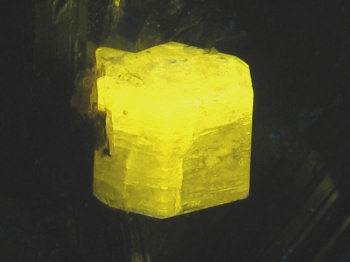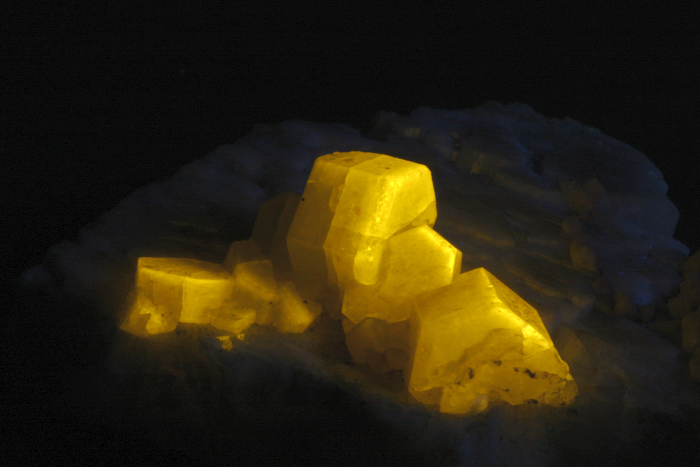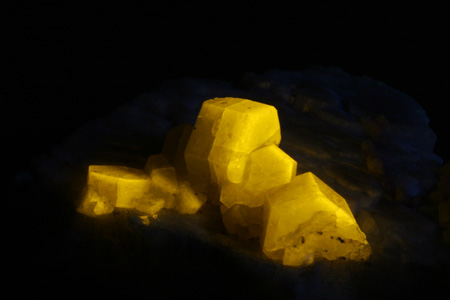Database of luminescent minerals
FLUORAPATITE
Chemical formula: Ca5(PO4)3F
Family: Phosphates, Arseniates, Vanadates
Status: IMA-GP
Crystal system : Hexagonal
Display mineral: OUI
Associated names (luminescent varieties, discredited names, synonyms, etc.): apatite, manganapatite, sombrerite,
Luminescence:
Longwave UV (365nm) colors: |
Pale Yellow , White , Bluish White , Yellowish White , Pinkish White , Pale Yellow , Yellow , Orangy yellow , Dark Orange /Tawn , Tawn , Orange Red , Violet Pink , Salmon pink , Yellowish Green , Green , Greenish , Greenish white , Violet blue , Yellowish , | ||
Intensity LW:Weak | |||
Midwave UV (320nm) colors: |
Violet , Yellowish White , Pinkish White , Pale Yellow , Yellow , Orangy yellow , Violet Pink , Greenish white , Violet blue , | ||
Intensity MW:Medium | |||
Shortwave UV (254nm) colors: |
Orangy yellow , Bluish White , Yellowish White , Pinkish White , Pale Yellow , Yellow , Orangy yellow , Orange , Dark Orange /Tawn , Tawn , Violet Pink , Greenish Yellow , Yellowish Green , Green , Greenish , Blue , Greenish white , Yellowish , | ||
Intensity SW:Strong | |||
Daylight picture

FLUORAPATITE, Pakistan;
Col. G.Barmarin; Photo: G. Barmarin
Longwave (365nm) picture

FLUORAPATITE, Pakistan; UVLW;
Col. G.Barmarin; Photo: G. Barmarin
Shortwave (254nm) picture

FLUORAPATITE, Pakistan; UVSW;
Col. G.Barmarin; Photo: G. Barmarin
Pictures Galery:



 ...
...  Go to the galery (28 pictures)
Go to the galery (28 pictures)
Do you have a photo of this mineral you would like to see in the gallery? Contact us!
Phosphorescence (in the common sense of the term) observable with the naked eye:
No data
Thermoluminescence: OUI
Comments:
Variété MANGANAPATITE: OL et OC: jaune, orange ; Activators: Eu2+, Ce3+, Mn2+, Dy3+, Nd3+, Sm3+ and Sm2+; TR3+ are located in the high symmetry Ca(I) position (Gorobets, Marfunin, Waychunas). Large pics: Mn2+ 569 nm, Mn3+ 583nm (yellow band); Other activator: U: 467, 486, 505, 526, 550 nm (gaft); Blue and violet luminescent colors due to Ce3+ and Eu2+; pink, violet pink, yellow pink: Sm3+, Dy3+; yellow band due to Mn2+ (Marfunin) The luminescence spectrum of fluorapatite from Panasqueira, Portugal, is characterized by four emission bands 349 nm (bandwidth:,10 nm) (REE possibly Ce3+); 445 nm (40nm)(REE possibly Eu2+); 555 rm (100 nm)(Mn2+ + REE sensitization (co-activator/UV absorber) most probably Ce3+ and Eu2+); 701 nm (50 nm)(Unknown activator). (Source see link to article below) The diversity of the luminescence in Apatite is created in part by: - the ability of the apatite structure to incorporate transition metal, REE and anion impurity activators and co-activators, often in combination; - the varying types of associations and formation conditions that promote luminescence activity; and - the nature of the structure of the apatite host itself. This favorable and flexible host structure has not been lost to commercial enterprises, as apatites have long been used as synthetic phosphors in industrial and consumer products. (Apatite Luminescence, Glenn A. Waychunas, Reviews in Mineralogy and Geochemistry; January 2002; v. 48) Ninety-five percent of the phosphorus on Earth belongs to the minerals of the apatite group Synthetic fluorapatite doped with manganese-II and antimony-V formed the basis for the second generation of fluorescent tube phosphors referred to as halophosphors (before 1942, synthetic Mn-doped willemite was used). When irradiated with 253.7 nm mercury resonance radiation they fluoresced with broad emission which appeared within the range of acceptable whites. The antimony-V acted as the primary activator and produced a broad blue emission. The addition of manganese-II produced a second broad peak to appear at the red end of the emission spectrum at the expense of the antimony peak, excitation energy being transferred from the antimony to the manganese by a non-radiative process and making the emitted light appear less blue and more pink. Replacement of some of the fluoride ions with chloride ions in the lattice caused a general shift of the emission bands to the longer wavelength red end of the spectrum. These alterations allowed phosphors for Warm White, White and Daylight tubes, (with corrected color temperatures of 2900, 4100 and 6500 K respectively), to be made. The amounts of the manganese and antimony activators vary between 0.05 and 0.5 mole percent. Sometimes some of the calcium was substituted with strontium giving narrower emission peaks. Since about 1990 the third generation TriPhosphors, three separate red, blue and green phosphors activated with rare-earth ions and mixed in proportions to produce the desired color, have largely replaced halophosphors.
Activator(s) and spectrum:
Activator(s): Mn2+ , (UO2)2+ (ion Uranyle) en impureté, Sm2+, Eu2+, Ce3+, Sm3+, Eu3+, Dy3+, Er3+, Tb3+, Pr3+, Nd3+, Gd3+, Yb3+, Yb2+, Tm3+,
Peaks in the spectrum (nm):
Gd3+: 307,312nm U: 467, 486, 505, 526, 550nm Mn3+: 583nm
Tm3+: 364nm
Ce3+: 375-400
Tb3+: 383, 387, 389, 411, 415, 420, 436, 439, 443, 446nm (in Ca(I) position)
Tm3+: 452,703
Eu2+: 450-460 (in Ca(I) & Ca(II) position)
Mn2+ (repl. Ca2+): 569nm (decaytime: 1,5ms) (in Ca(I) & Ca(II) position & adsorption on carbonate-fluor-apatite surface)
Dy3+: narrow lines at 470, 475, 478, 481, 488,485, 570, 575, 580, 586, 579, 651, 656, 661, 664 nm (in Ca(I) position)
Sm3+: 560, 563, 565, 593, 595,599, 603, 604, 637, 639, 641, 646, 651, 695, 704, 710, 652 nm (in Ca(I) & Ca(II) position)
Ce3+: 543nm (in Ca(I) & Ca(II) position) (decaytime: 20ns)
O2 in channels: 687, 762nm
H2O in channels: 719, 729, 817, 823, 829nm
MnO3-4 repl. PO3-4:, 1143, 1158nm
Eu3+: 573, 616, 631, 578, 608, 615, 627, 579, 590, 618, 653, 700nm (in Ca(I) position)
Sm2+: 689, 691, 695, 704, 708, 711, 716, 724, 726, 733, 736, 749,773, 774, 778, 798, 815nm
Nd3+: 862, 873, 880, 890, 893, 897,910, 1058, 1065, 1070nm (in Ca(I) position)
Yb3+: 993nm (Ca(II) position)
Pr3+: (in Ca(I) position)
Er3+: (in Ca(I) position)

Spectrum: Michael Gaft, Petah Tikva, Israel. Plot: Institute of Mineralogy, University of Vienna, Austria, with permission of the authors.
Spectrum Galery:



 ...
...Comments on spectrum and activators:
The structure of the apatite is hexagonal, with the symmetry group P63/m. There are two different sites for the Ca2+ in this structure: 40 % of Ca2+ ions are associated with the Ca(I) sites and 60 % are associated with Ca(II) sites. The point group symmetry of the Ca(I) site is C3, with each Ca having six oxygen nearest neighbors that form a distorted triangular prism about the Ca2+ ion. The Ca(II) site has Cs symmetry with the Ca2+ ions sitting at the corners of equilateral triangles with an F ion in the center (see Gaft). In nature, REE can easily substitute for Ca, becoming luminescence centers. With steady-state luminescence spectroscopy, it was discovered that Eu2+, Ce3+, Mn2+, Dy3+, Nd3+, Sm3+ and Sm2+ mainly determine apatite luminescence. It was established that REE3+ have been detected only in the high symmetry Ca(I) position. (see Gaft)
Best localities for fluorescence (*):
- Chumar Bakhoor, Hunza Valley, Gilgit District, Gilgit-Baltistan, Pakistan;
- Shigar Valley, Skardu District, Pakistan (bright yellow SW);
- Bulochi, Astor valley, Astor District, Gilgit-Baltistan, Pakistan (orange SW + yellow SW);
- Shengus, Haramosh Mts., Skardu District, Baltistan, Gilgit-Baltistan, Pakistan (bright yellow SW);
- Nagar, Hunza Valley, Gilgit District, Gilgit-Baltistan, Pakistan (bright yellow SW);
- Dassu, Braldu Valley, Skardu District, Baltistan, Gilgit-Baltistan, Pakistan (bright yellow SW);
- Niaslo, Basha Valley, Skardu District, Gilgit-Baltistan, Pakistan (orange LW+SW)
- Paprook, Kunar Province, Afghanistan;
- Dara-i-Pech pegmatite field, Chapa Dara District, Konar Province, Afghanistan (bright yellow SW);
- Mawi pegmatite, Nilaw-Kolum pegmatite field, Du Ab District, Nuristan Province, Afghanistan (weak zoned yellow SW);
- Laghman Province, Afghanistan (strong yellow SW);
- Panasqueira Mine - Couto Mineiro da Panasqueira, Panasqueira, Covilhã, Castelo Branco District, Portugal;
- Ojuela Mine, Mapimi, Durango, Mexico;
- Otter Lake, Quebec, Canada (purple MW);
- Sapo Mine, Ferruginha, Conselheiro Pena, Doce valley, Minas Gerais, Brazil (zoned fluorescence SW+LW);
- Cerro de Mercado Mine, Victoria de Durango, Cerro de los Remedios, Mun. de Durango, Durango, Mexico (weak blue SW);
- Imilchil, Er Rachidia Province, Meknès-Tafilalet Region, Morocco (weak pink, SW)
- Calumet Orebody, Iron County, Utah, USA (pink SW);
(*)The data are not exhaustive and are limited to a few remarkable localities for fluorescence
Bibliographic reference for luminescence:
- The Henkel Glossary of Fluorescent Minerals, Dr. Gerhard Henkel, Published by the FMS, 1989 ,
- Fluorescence: Gems and Minerals Under Ultraviolet Light, Manuel Robbins, 1994, Geoscience Press, ISBN 0-945005-13-X ,
- The World of Fluorescent Minerals, Stuart Schneider, Schiffer Publishing, 2006, ISBN 0-7643-2544-2 ,
- Luminescence Spectroscopy of Minerals and Materials, M. Gaft, R. Reisfeld, G. Panczer, Springer Editor, ISBN: 10 3-540-21918-8 ,
- Luminescent Spectra of Minerals, Boris S. Gorobets and Alexandre A. Rogojine, Moscow, 2002 ,
Reference for luminescence on the Internet:
- Knutson C, Peacor D R, Kelly W C (1985) Luminescence, color and fission track zoning in apatite crystals of the Panasqueira tin-tungsten deposit, Beira-Baixa, Portugal, American Mineralogist 70, 829-837 (http://rruff.info/rruff_1.0/uploads/AM70_829.pdf)
- Luminescence properties of rare earth ions in fluorite, apatite and scheelite minerals, M. Czaja, S. Bodył, P. Głuchowski, Z. Mazurak and W. Strek, Journal of Alloys and Compounds Volume 451, Issues 1-2, 28 February 2008, Pages 290-292
- https://en.wikipedia.org/wiki/Fluorapatite
- https://www.academia.edu/21627789/Luminescence_of_uranium_and_rare-earth_elements_in_apatite_of_fossil_fish_teeth
- https://www.academia.edu/21627776/Eu3_luminescence_in_high-symmetry_sites_of_natural_apatite
- MONT-SAINT-HILAIRE, History, Geology, Mineralogy, Laszlo HORVATH, The Canadian Mineralogist, Special Publication 14, 2019
Images:
- Cerro de Mercado Mine, Durango, Mexico: http://www.mindat.org/photo-531601.html
- Cerro de Mercado Mine, Durango, Mexico: http://www.mindat.org/photo-568024.html & http://www.mindat.org/photo-568025.html
- Cerro de Mercado Mine, Durango, Mexico: http://www.mindat.org/photo-689021.html
- Konar Province, Afghanistan: http://www.mindat.org/photo-332082.html
- Konar Province, Afghanistan: http://www.mindat.org/photo-377897.html
- Laghman Province, Afghanistan: http://www.mindat.org/photo-651123.html
- Mawi pegmatite, Nuristan Province, Afghanistan: http://www.mindat.org/photo-602537.html
- Skardu District, Baltistan, Gilgit-Baltistan, Pakistan (bright yellow SW): http://www.mindat.org/photo-315712.html
- Skardu District, Baltistan, Gilgit-Baltistan, Pakistan (bright yellow SW): http://www.mindat.org/photo-332080.html
- Shigar Valley, Skardu, Pakistan (yellow SW): http://www.mindat.org/photo-524833.html
- Nagar, Hunza Valley, Pakistan (pink LW): http://www.mindat.org/photo-433687.html
- Nagar, Hunza Valley, Pakistan (yellow SW): http://www.mindat.org/photo-527114.html
- Bulochi, Gilgit-Baltistan, Pakistan (orange SW): http://www.mindat.org/photo-450226.html
- Bulochi, Gilgit-Baltistan, Pakistan (yellow LW): http://www.mindat.org/photo-450227.html
- Niaslo, Basha Valley, Skardu District, Gilgit-Baltistan, Pakistan : https://www.mindat.org/photo-541460.html
- Panasqueira Mines, Covilhã, Castelo Branco, Portugal: https://www.mindat.org/photo-787698.html
Videos:
Mineralogical reference on the Internet:
 http://www.mindat.org/show.php?name=Fluorapatite
http://www.mindat.org/show.php?name=Fluorapatite
 http://webmineral.com/data/Fluorapatite.shtml
http://webmineral.com/data/Fluorapatite.shtml
Internet Search:
 Image search on 'Google Images'
Image search on 'Google Images'
 Search for documents in all languages on Google
Search for documents in all languages on Google
A request providing no result means only that no such reference exists in the database, but it does not mean that what you are looking for does not exist, just not to our knowledge. If you think you have found an error or omission, please let us know via the contact page being sure to cite the source of information.
